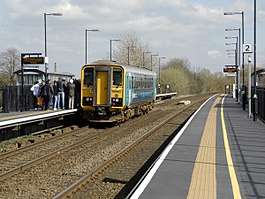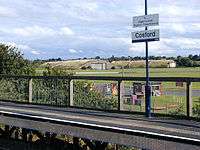Cosford railway station
Cosford railway station is a two platform station on the former Great Western Railway's London Paddington to Birkenhead via Birmingham Snow Hill line. The station buildings at platform level are a little unusual compared with other stations on the line in that they are constructed entirely of timber. Nearby is RAF Cosford which is also home to a branch of the Royal Air Force Museum.
| Cosford | |
|---|---|
 An Arriva Trains Wales train pauses to collect passengers on a Sunday service at Cosford | |
| Location | |
| Place | Cosford |
| Local authority | Shropshire Council |
| Grid reference | SJ797052 |
| Operations | |
| Station code | COS |
| Managed by | West Midlands Trains |
| Number of platforms | 2 |
| DfT category | F2 |
| Live arrivals/departures, station information and onward connections from National Rail Enquiries | |
| Annual rail passenger usage* | |
| 2014/15 | |
| 2015/16 | |
| 2016/17 | |
| 2017/18 | |
| 2018/19 | |
| History | |
| Key dates | Opened 1937[1] |
| National Rail – UK railway stations | |
| * Annual estimated passenger usage based on sales of tickets in stated financial year(s) which end or originate at Cosford from Office of Rail and Road statistics. Methodology may vary year on year. | |
The station is served by West Midlands Trains, who manage the station, and Transport for Wales. Between 2008 and 2011 it was also served by the direct London operator, Wrexham & Shropshire.
History

The line between Shrewsbury and Wolverhampton was opened as a through route in November 1849.[3] Cosford station was opened much later than other stations on the line when the decision was taken to site an RAF base there just before the start of the Second World War. Originally the station was known as Cosford Aerodrome Halt, but due to wartime security concerns, this was shortened to just Cosford in 1940.[4] Trains originally ran to Wolverhampton Low Level and the GWR main line to Birmingham Snow Hill eastbound, but were diverted to Wolverhampton High Level and the ex-LNWR Stour Valley line to Birmingham New Street in 1967.
2011-12 reconstruction
The station was closed to passengers from 29 October 2011 until 30 April 2012.[5][6] Costing £2.1 million Network Rail replaced the wooden 1937 station buildings as well as the platforms, which were constructed from century-old wood railway sleepers with the new platforms made from glass reinforced polymer, and the stairs leading up to them.[7][8] Its re-opening was delayed by 5 weeks.[6] The redevelopment has been criticised for a lack of disabled access.[9]
Signal box
The most recent Cosford signal box stood a little to the west of the station. As well as forming a block post this signal box controlled entrance and exit to up and down refuge loops and the previous rail connection into the adjacent RAF site from the up refuge loop. It has been abolished as a result of the 2006 resignalling scheme with control passing to Madeley Junction.[10] Much of the redundant signalling equipment has been distributed to various heritage railways, the Gloucestershire Warwickshire Railway is believed to have received the majority. This structure is thought to have been the last signal box constructed by the Great Western Railway in Shropshire. Much of the contents and structure of this 1939 constructed signalbox has been salvaged for reuse on another heritage railway. The remaining brickwork was demolished in the small hours of Sunday 21 October 2007. Remarkably, the signalman's portacabin style privy remains in-situ as of late August 2008. The advent of longer trains destined for Ironbridge Power Station has resulted in much reduced used of the refuge loops as they are too short to accommodate the length of today's coal trains.[11]
Services
There is a basic hourly off-peak service in each direction (Monday to Sunday), westbound to Shrewsbury and eastbound to Wolverhampton and Birmingham New Street run by West Midlands Trains. Additional trains call at peak periods.[12][13]
References
- Cryer, Geoff (2014). "GWR & LMS". Shropshire Railways. Marlborough: Crowood. p. 63. ISBN 978 1 84797 691 8.
- Cryer, Geoff (2014). "GWR & LMS". Shropshire Railways. Marlborough: Crowood. p. 63. ISBN 978 1 84797 691 8.
- Cryer, Geoff (2014). "The coming of the main lines". Shropshire Railways. Marlborough: Crowood. p. 23. ISBN 978 1 84797 691 8.
- Clarke, Neil (2015). Railways of East Shropshire. Stroud: Amberley. p. 37. ISBN 9781445640228.
- National Rail Archived 2011-09-19 at the Wayback Machine Engineering work at Cosford station from Saturday 29 October 2011 until March 2012
- Shropshire Star Cosford railway station reopens after six-month refit (30 April 2012)
- Shropshire Star £3.5 million revamp for Shropshire railway stations (13 October 2011)
- BBC News Cosford railway station shut during £2.1m scheme work (13 October 2011)
- "Cosford station: No funding for disabled access". BBC. 28 May 2012. Retrieved 24 September 2012.
- "Rail line to close for nine days". BBC News. 14 March 2006. Retrieved 8 May 2016.
- Jackson, Allen (2015). Contemporary Perspective on GWR Signalling: Semaphore Swansong. Ramsbury: The Crowood Press. p. 276. ISBN 9781847979490.
- "'Major' rail changes in timetable overhaul". BBC News. 19 May 2019. Retrieved 24 July 2019.
- O'Brien, Lisa (13 March 2019). "New timetable includes later rail services between Shropshire and West Midlands". The Shropshire Star. Retrieved 24 July 2019.
Further reading
- Mitchell, Vic; Smith, Keith (2009). Wolverhampton to Shrewsbury. Middleton Press. figs. 71-74. ISBN 9781906008444. OCLC 286385795.
External links
| Wikimedia Commons has media related to Cosford railway station. |
- Train times and station information for Cosford railway station from National Rail
| Preceding station | Following station | |||
|---|---|---|---|---|
| Albrighton | Transport for Wales Birmingham - Chester |
Shifnal | ||
| West Midlands Railway Wolverhampton/Birmingham-Shrewsbury Mondays-Saturdays only |
||||